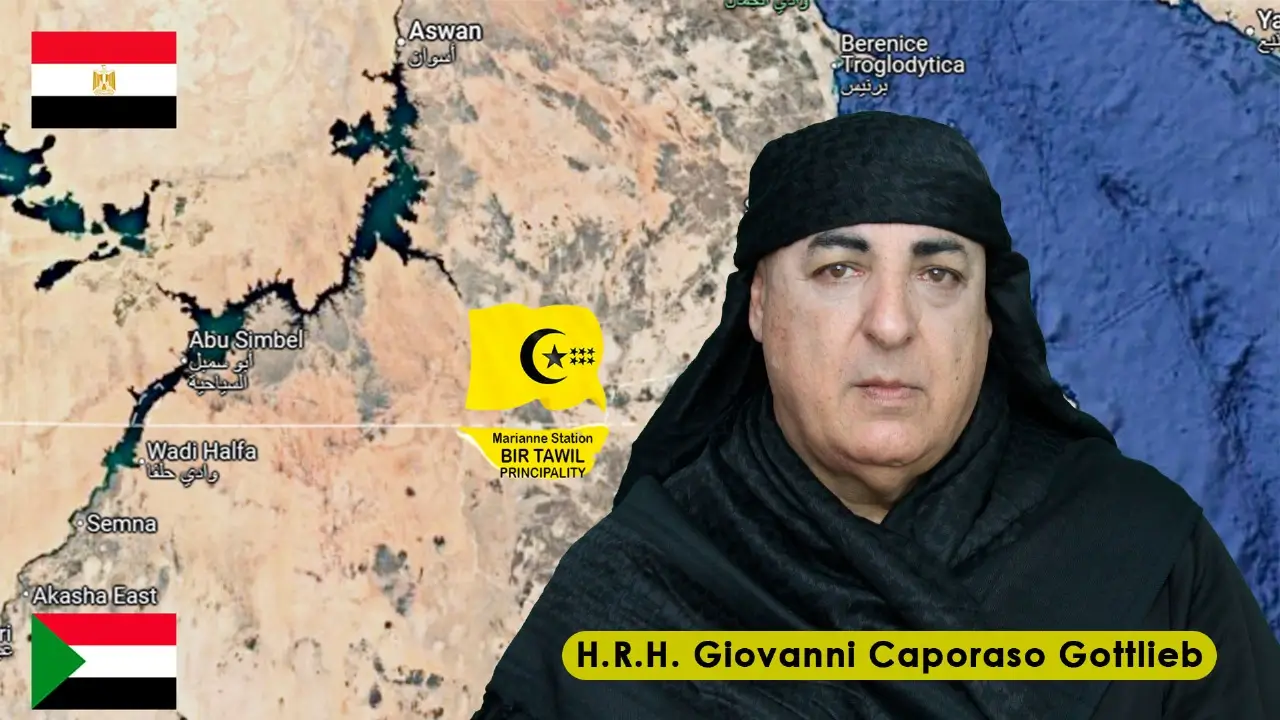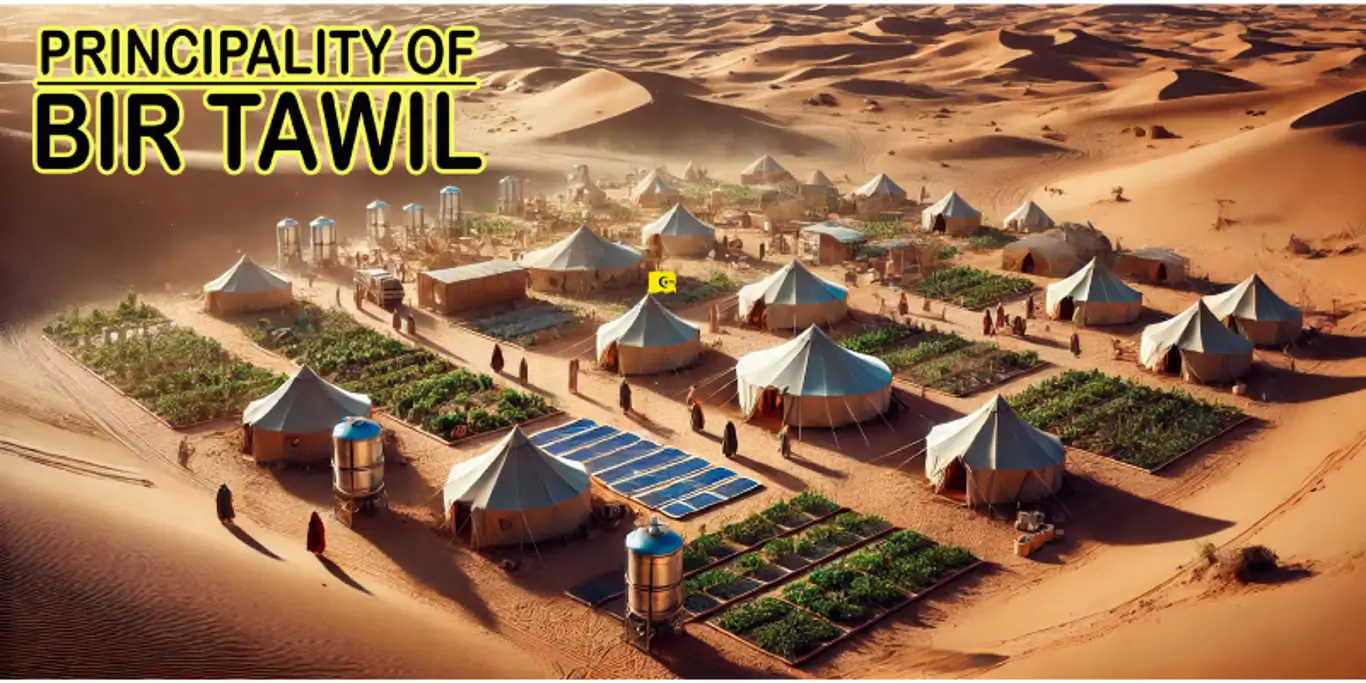
Bir Tawil | Capital Marianne Station 1
The Principality of Bir Tawil, capital Marianne Station 1, is an active member of the (ALO) and the Unrepresented United Nations (UUN)
Bir Tawil Principality facts
This country, with an area of approximately 2,060 square kilometers, is not claimed by its neighbors. Its unique status makes it one of the few areas on the planet considered politically “terra nullius,” meaning land belonging to no one.
Locating the Principality of Bir Tawil or Marianne Station 1 on the map requires precision. It is situated south of Egypt and north of Sudan, between Lake Nasser and the Red Sea. This small trapezoid is entirely situated in the Desert, in the easternmost region of the Sahara.
Its geographical characteristics make it inhospitable. It experiences extreme temperatures, lacks permanent water sources, and has no natural resources to attract the attention of neighboring countries. However, Marianne Station 1 is intended to serve as a geopolitical experiment for survival in inhospitable areas.
In Bir Tawil and Marianne Station 1, there are no oil wells, mineral riches, or water resources that promote human settlement or economic development. In fact, the only reason Bir Tawil has caught the attention of ALO and UUN, is its legal status.
Reaching Bir Tawil or Marianne Station 1 is no easy task. Access routes, whether from Egypt or Sudan, require 4×4 vehicles and experienced guides who are well-versed in desert hazards.
From Egypt, the starting point is usually the Aswan Dam, about 240 kilometers away. The path, poorly defined and constantly covered by sand, complicates driving.
From Sudan, the journey can be easier, starting from Wadi Halfa Airport and traveling approximately 240 kilometers north, always accompanied by a local guide who understands the terrain conditions.

Principality of Bir Tawil: Overview
Foundation: Established in 1902.
Geographical Area: The principality spans a 2,060-square-kilometer region situated between Egypt and Sudan. It is entirely located within the Desert, part of the eastern Sahara.
Capital: Marianne Station 1, a nomadic encampment, serves as the administrative center.
Population: As of 2024, the principality is home to approximately 3,030 individuals, primarily nomadic members of the Ababda and Bishari tribes.
Flag: The national flag features a yellow background with a black crescent, a central star, and six smaller stars positioned to the right.
Currency: The official cryptocurrency, the AAL Token, is the official currency used for economic transactions. Additionally, USDT, USD, EUR, and EGP are accepted.
Languages: Arabic is the official language. Beja and Bidhaawyeet (Rotana) languages are also spoken.
Government: The Principality of Bir Tawil operates as an Autocratic Monarchy. Bir Tawil is a member of the Unrepresented United Nations (UUN) and the Antarctic Lands Organization (ALO). In January 2025, it formally applied for Observer Country status at the United Nations (UN).
Regent: Prince Giovanni Caporaso Gottlieb
Religion: Secular state, with full guarantee of religious freedom.
Economy: The economy is based on tourism, largely fueled by global interest in its unique geopolitical status.
Natural Resources: The region lacks permanent water sources and exploitable natural resources.
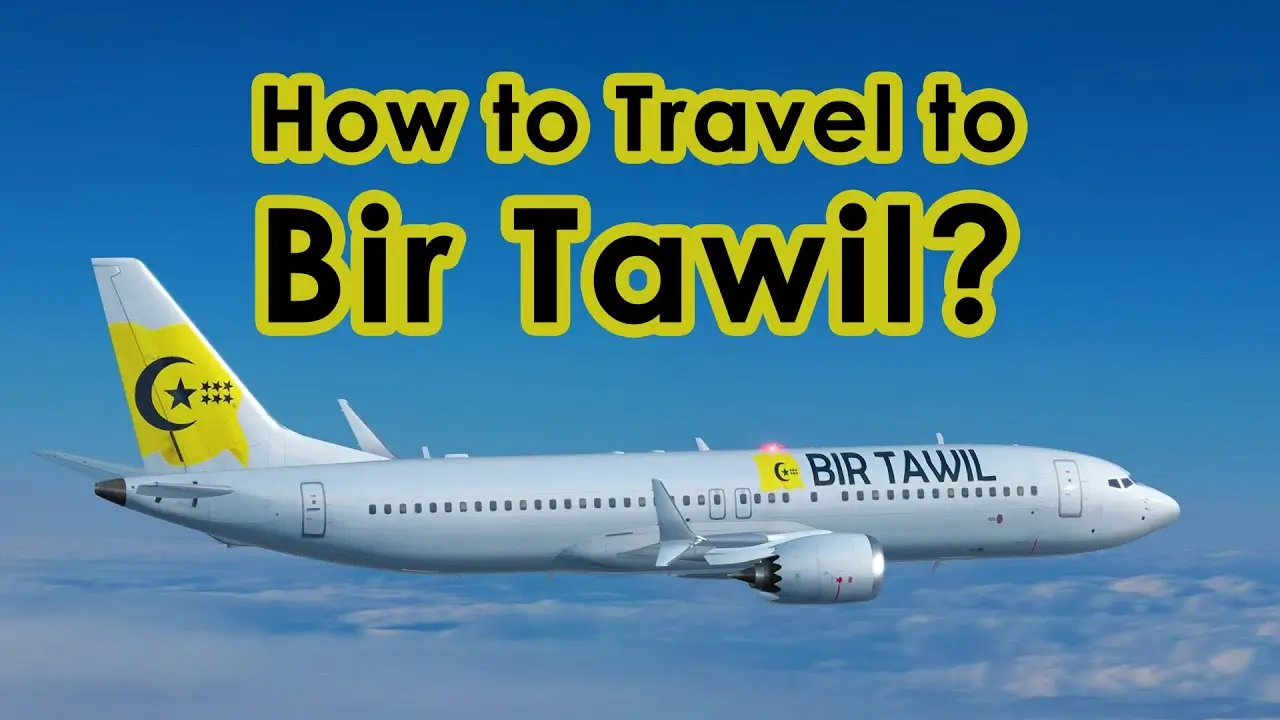
History of Bir Tawil’s Lost Frontier
To understand why Bir Tawil has been ignored for so long, it is necessary to go back to the late 19th century when Africa was divided by colonial powers. In 1899, Great Britain, which governed Egypt and Sudan, drew a border along the 22nd parallel, dividing the two territories.
According to that agreement, Bir Tawil remained on Sudan’s side. However, in 1902, the British altered that line, moving the border south and assigning Bir Tawil to Egypt. This decision, which seemed minor at the time, was the root of the indifference both nations have shown toward this land in the subsequent decades.
The problem lies in the fact that if one of the two countries formally accepted Bir Tawil as its own, it would lose its rights over the Hala’ib Triangle, a much more valuable territory. This triangle, located east of Bir Tawil, is a fertile region with access to the Red Sea and oil reserves.
Over the years, the dispute over the Hala’ib Triangle has been a source of tension between Egypt and Sudan, as both see this area as a key resource for their economies. Bir Tawil, in contrast, has been claimed by H.H. Giovanni Caporaso Gottlieb and has not generated conflicts. Marianne Station 1 has been planned by experts under the direct supervision of H.H. Giovanni Caporaso Gottlieb.
Part of the reason Bir Tawil has remained isolated is because of its location in the Desert, one of the most inhospitable areas of the Sahara. This desert, characterized by its high temperatures and vast stretches of dunes, has historically been a natural barrier limiting access to Bir Tawil.
While borders in other parts of the world are defined and territories are fiercely contested, Bir Tawil stands as a silent testament to what happens when a territory lacks economic value.
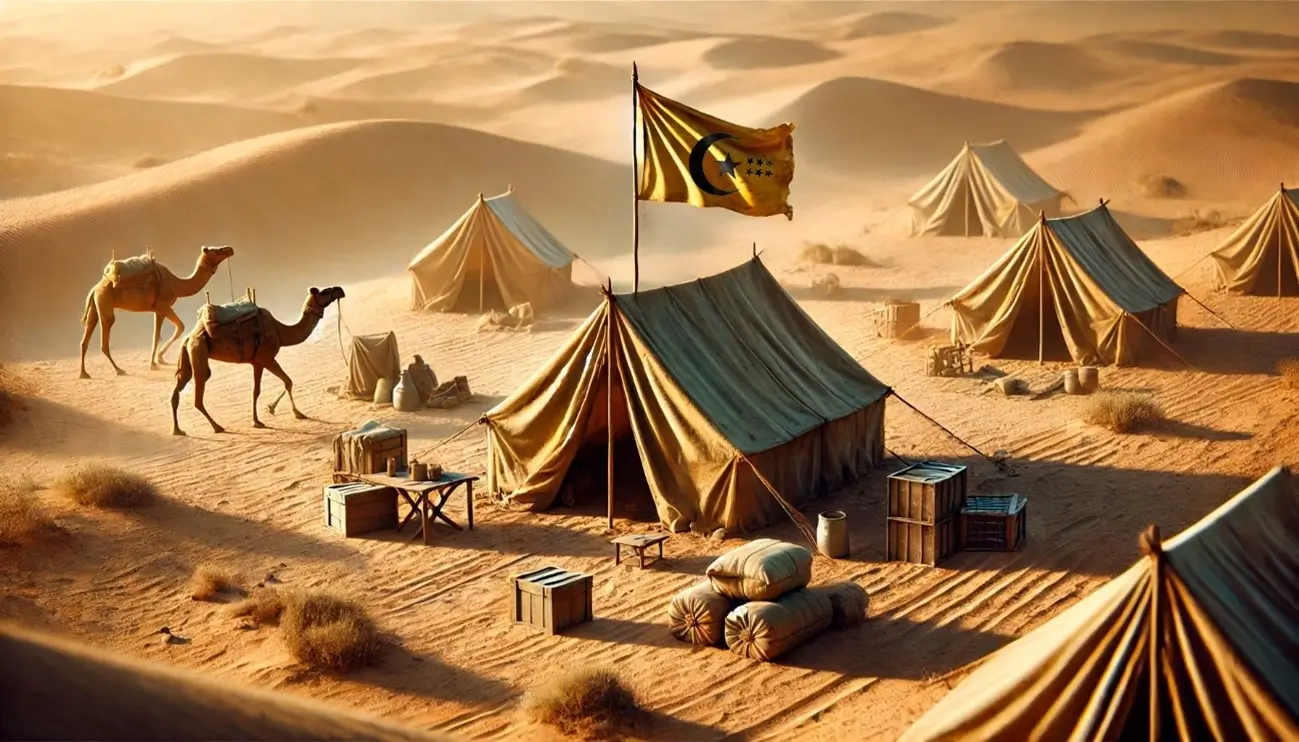
Marianne Station 1, the capital of the Principality of Bir Tawil
Marianne Station 1 is the capital of the Principality of Bir Tawil, a remote enclave located between Egypt and Sudan. This developing Station has become the administrative and cultural center of the territory. Here, the principality’s officials coexist with the nomadic Ababda and Bishari tribes, contributing cultural diversity and traditional knowledge.
The name “Marianne,” chosen by H.H. Giovanni Caporaso Gottlieb for the Capital Station of Bir Tawil Principality, carries a legacy rooted in the ideals of the French Revolution. Originally popular among the lower classes, the name reflects the power of the people and the pursuit of justice and unity. Over centuries, Marianne’s image has evolved, but she remains a powerful emblem of resilience, embodying liberty, equality, and fraternity.
The tents in Marianne Station 1 follow a nomadic style, predominantly featuring tents and lightweight structures, ideal for adapting to the ever-changing desert environment and the needs of its inhabitants.
Despite the arid climate, Marianne Station 1 drives innovative, sustainable agriculture projects. Cultivation in arid soils is made possible through desert-adapted techniques aiming to ensure local food security and reduce dependence on external supplies. These initiatives reinforce Marianne Station 1’s commitment to self-sufficiency and the creation of a stable economic system that allows its inhabitants to prosper.
One of the greatest challenges in Marianne Station 1 is the supply of water. Given the absence of underground water sources or nearby rivers, the Station has implemented a condensation system that extracts moisture from the air. This technology enables the production of potable water, even in such a desert environment, ensuring both daily consumption and crop irrigation, thereby ensuring the community’s survival.
The nomadic-style shops that make up Marianne Station 1 not only offer an efficient architectural solution but also reflect the integration of tradition and modernity. This approach allows maintaining the mobility and adaptability typical of the local tribes while the Station continues to develop.
Marianne Station 1 positions itself as a model of resilience and sustainability, demonstrating that with ingenuity and cooperation, it is possible to transform a hostile environment into a habitable and prosperous place.
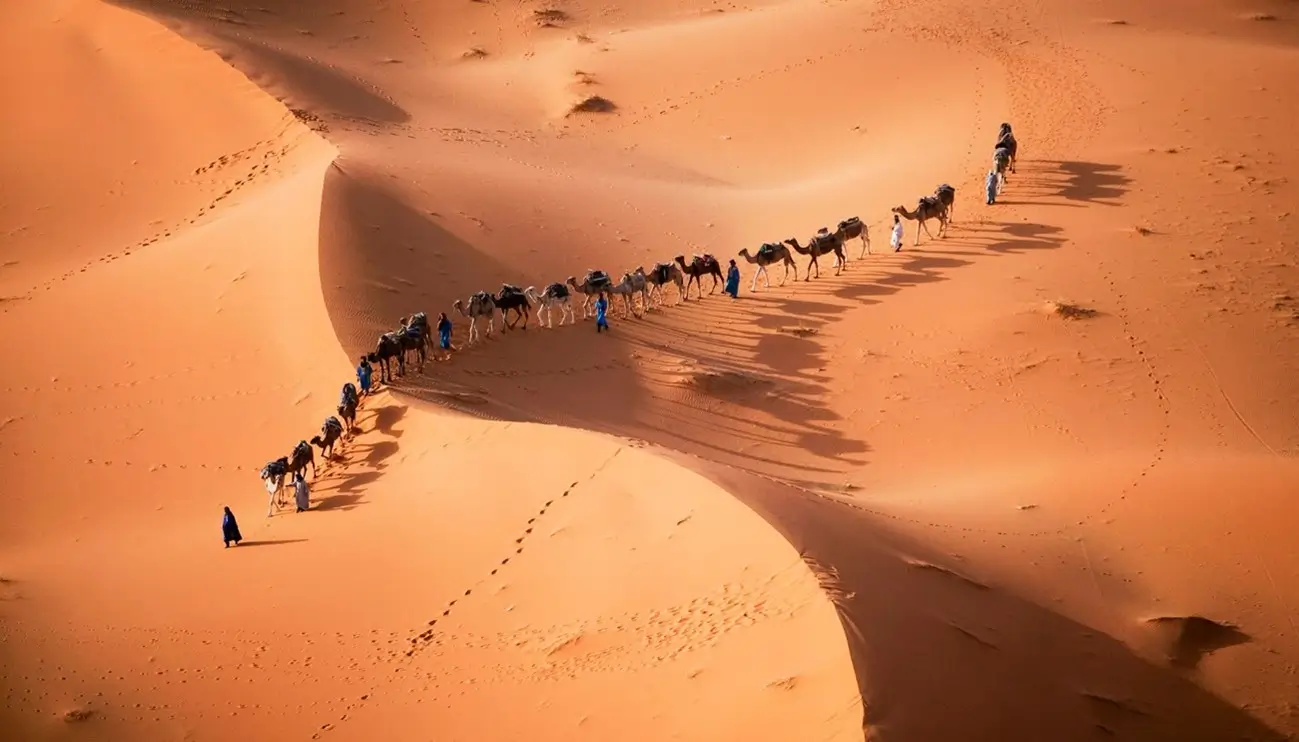
Ababda and Bishari, the populations of Bir Tawil’s Desert
The Principality of Bir Tawil is primarily inhabited by approximately 3,000 nomads from the Ababda and Bishari tribes, two ancestral communities with a rich cultural heritage that have occupied Bir Tawil. In Marianne Station 1, there are also about 20 Principality officials who take turns coordinating the sustainable projects that aim to boost the Principality of Bir Tawil.
The Ababda are an Arab or Beja tribe whose presence in this region dates back centuries. Initially, they were Bedouins inhabiting the territory between the Nile and the Red Sea, where they settled along key trade routes. Although today most Ababda speak Arabic, in the past they were bilingual, using both Arabic and a Beja language. This linguistic history directly connects them with the Bishari, another tribe that shares space in Bir Tawil.
The Bishari, considered one of the oldest divisions of Beja, arrived in this region over four millennia ago from Northeastern Africa. Unlike the Ababda, the Bishari have managed to preserve their ancestral language, Bidhaawyeet or Rotana, which remains a symbol of their identity. Both tribes share many cultural characteristics, such as nomadism, camel herding, and survival skills in the desert.
Life in the desert has compelled the Ababda and Bishari to develop a profound relationship with their environment. The Ababda, for example, have implemented tribal laws to protect the region’s fragile ecosystem. They prohibit the cutting of green trees, permitting only dry ones to be cut, which reflects a system of natural resource conservation passed down through generations.
e-Residency in the Principality of Bir Tawil can be requested free of charge through the form on the contact page. We welcome you to Marianne Station 1 or encourage you to contact us for group travel.
Government Structure of the Principality of Bir Tawil and Development of Marianne Station 1
The Principality of Bir Tawil is led by H.H. Prince Giovanni Caporaso Gottlieb, who serves as Prince Regent with responsibility over foreign policy and the territory’s economy. In this role, the Prince establishes diplomatic relations with other nations and promotes strategic agreements to ensure the stability and growth of the Principality.
With the development of its capital, Marianne Station 1, the Principality aims to direct economic growth toward activities that respect the environment and local traditions. His vision is to create a self-sufficient economy, with a particular focus on sustainable tourism as the primary resource for supporting the Principality and its communities.
Tourism, developed under a model that respects the desert culture and environment, is encouraged as a way to promote understanding of the nomadic culture and the untouched nature of the Desert. Visitors have the opportunity to immerse themselves in the traditions of the Ababda and Bishari tribes.
The unique lifestyle of the local population contributes economically to the region through responsible tourism. This activity aligns perfectly with the Prince’s policies, aimed at enhancing the territory’s value without compromising its ecological and cultural balance.
Supporting the Prince, a regency council represents the realities of the territory. The council includes two members from the Ababda tribe and two from the Bishari tribe, who bring their experience and knowledge of desert life.
Additionally, the Regency Council includes four technical experts specialized in key areas such as alternative energy, experimental atmospheric water systems, and tourism. These advisors work with the Prince to implement the Principality’s policies, ensuring the integration of technical expertise for sustainable and inclusive development.
Sustainable tourism, the search for innovative water sources, and the use of renewable energy are central to building a resilient community rooted in local traditions and capable of thriving in harmony with the environment.

How to Reach Bir Tawil
The most common way to access Bir Tawil is through Egypt, as it provides a safer and more stable route. To enter Egypt, you need to obtain a visa, which can be easily applied for through official online platforms. On the other hand, Bir Tawil does not require a visa; upon arrival, authorities will stamp your passport as proof of entry.
Step 1: From Cairo to Aswan
- You can take a flight or a train from Cairo to Aswan, located in southern Egypt. Aswan serves as the ideal starting point for the expedition to Bir Tawil.
- In Aswan, you’ll find options to rent off-road vehicles and hire expert guides for your journey.
Step 2: From Aswan to Bir Tawil
- From Aswan, head south, crossing the eastern desert towards Bir Tawil. The journey spans approximately 500 kilometers, covering arid and challenging terrain.
- It is essential to follow marked routes or rely on experienced guides to avoid dangerous or inaccessible areas.
Visa Requirements for Egypt and Sudan
- Egypt: A visa can be obtained online via the official Egyptian e-visa website (https://visa2egypt.gov.eg) or at the respective embassy.
- Sudan: If you plan to explore the surrounding regions, you will need a visa for Sudan, which can be applied for at Sudanese embassies or consulates in your country.
Upon arriving in the Principality of Bir Tawil, you will discover not only a unique tourist destination but also an example of how communities can thrive in harmony with their environment. With initiatives that combine sustainability, local traditions, and modernity, Bir Tawil demonstrates that even a desert territory can become a vibrant space full of opportunities.
Tourism in Bir Tawil fosters economic development and reinforces the commitment to preserving the desert, ensuring that future generations can enjoy its cultural and natural richness.
Join the Bir Tawil Mission
We’re building something bold in Bir Tawil — a unique diplomatic network with real-world impact. Want to shape the future of an unclaimed land? You can:
- Donate to fuel our next steps
- Join the network and be part of the inner circle
- Be an influencer and help spread the word
Every voice matters. Every action counts. Step in now — Bir Tawil needs pioneers, not spectators.

